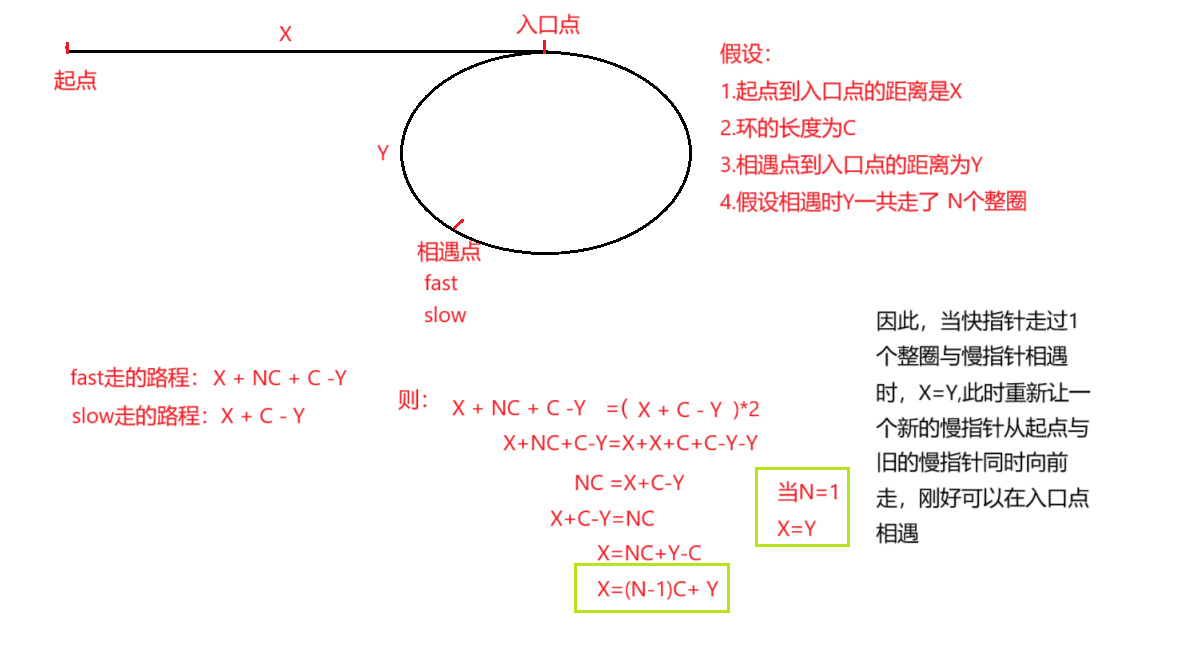数据结构青铜到王者第五话---LinkedList与链表(2)
目录
一、常见的链表题目练习(续)
1、链表的回文结构。
2、输入两个链表,找出它们的第一个公共结点。
3、给定一个链表,判断链表中是否有环。
4、给定一个链表,返回链表开始入环的第一个节点。 如果链表无环,则返回 NULL
二、LinkedList
1、LinkedList的模拟实现
2、LinkedList的使用
2.1什么是LinkedList
2.2LinkedList的使用
2.2.1LinkedList的构造
2.2.2LinkedList的其他常用方法介绍
2.2.3LinkedList的遍历
3、ArrayList和LinkedList的区别
续接上一话
一、常见的链表题目练习(续)
1、链表的回文结构。
(链表的回文结构_牛客题霸_牛客网)
和前面一样,先使用快慢指针找到中间结点,再用第2题的方法将整个链表进行反转,再依次进行比较,看是否完全相同
public boolean chkPalindrome() {// write code hereif(head == null) return true;ListNode fast = head;ListNode slow = head;while (fast != null && fast.next != null) {fast = fast.next.next;slow = slow.next;}//slow 指向的位置 就是中间节点//2.进行翻转ListNode cur = slow.next;while (cur != null) {ListNode curN = cur.next;cur.next = slow;slow = cur;cur = curN;}//3.判断回文while (head != slow) {if(head.val != slow.val) {return false;}if(head.next == slow) {return true;}head = head.next;slow = slow.next;}return true;}2、输入两个链表,找出它们的第一个公共结点。
(160. 相交链表 - 力扣(LeetCode))
这里首先要清楚,两个链表如果有着公共结点,那么一定是Y字型的关系
小技巧:如果两个链表相交,那么同时出发,依次向后走一步,若是为空下一步走到另一个链表的头结点上,他们相遇时一定是在公共结点位置。(不相交则同时为null)
public class Solution {public ListNode getIntersectionNode(ListNode headA, ListNode headB) {if (headA == null || headB == null) {return null;}ListNode pA = headA, pB = headB;while (pA != pB) {pA = ((pA == null) ? headB : pA.next);pB = ((pB == null) ? headA : pB.next);}return pA;}
}3、给定一个链表,判断链表中是否有环。
(141. 环形链表 - 力扣(LeetCode))
这里依旧采用快慢指针,如果有环,那么一定会相遇,若是没有环,则快指针一定会先null
public class Solution {public boolean hasCycle(ListNode head) {if (head == null || head.next == null) {return false;}ListNode slow = head;ListNode fast = head.next;while (slow != fast) {if (fast == null || fast.next == null) {return false;}slow = slow.next;fast = fast.next.next;}return true;}
}那么,为什么我们要让fast和slow分别走2步和1步呢?能不能一个走3步,一个走2步呢?
首先要明确,若是一个走3步一个走1步,快指针可能刚好将慢指针进行套圈,永远无法相遇(如环的长度只有2,一个走3步一个走1步刚好永远无法相遇!!!)
而若是一个走3步,一个走2步,那么就会存在不确定性,如不确定什么时候可以相遇等。
4、给定一个链表,返回链表开始入环的第一个节点。 如果链表无环,则返回 NULL
(142. 环形链表 II - 力扣(LeetCode))

依旧使用快慢指针操作,当两个指针相遇时,快指针走的距离是a+n(b+c)+b=a+(n+1)b+nc
快指针的速度是慢指针的一倍,所以a+(n+1)b+nc=2(a+b) ==> a=c+(n−1)(b+c),我们会发现:从相遇点到入环点的距离加上 n−1 圈的环长,恰好等于从链表头部到入环点的距离。
因此,当发现 slow 与 fast 相遇时,我们再额外使用一个指针 ptr。起始,它指向链表头部;随后,它和 slow 每次向后移动一个位置。最终,它们会在入环点相遇。

public class Solution {public ListNode detectCycle(ListNode head) {if (head == null) {return null;}ListNode slow = head, fast = head;while (fast != null) {slow = slow.next;if (fast.next != null) {fast = fast.next.next;} else {return null;}if (fast == slow) {ListNode ptr = head;while (ptr != slow) {ptr = ptr.next;slow = slow.next;}return ptr;}}return null;}
}二、LinkedList
1、LinkedList的模拟实现

// 无头双向链表实现public class MyLinkedList {//头插法public void addFirst(int data) {ListNode node = new ListNode(data);if(head == null) {head = last = node;}else {node.next = head;head.prev = node;head = node;}}//尾插法public void addLast(int data) {ListNode node = new ListNode(data);if(head == null) {head = last = node;}else {last.next = node;node.prev = last;last = last.next;}}//任意位置插入,第一个数据节点为0号下标public void addIndex(int index, int data) {int len = size();if(index < 0 || index > len) {return;}if(index == 0) {addFirst(data);return;}if(index == len) {addLast(data);return;}ListNode node = new ListNode(data);ListNode cur = findIndex(index);node.next = cur;cur.prev.next = node;node.prev = cur.prev;cur.prev = node;}private ListNode findIndex(int index) {ListNode cur = head;while (index != 0) {cur = cur.next;index--;}return cur;}//查找是否包含关键字key是否在单链表当中public boolean contains(int key) {ListNode cur = head;while (cur != null) {if(cur.val == key) {return true;}cur = cur.next;}return false;}//删除第一次出现关键字为key的节点public void remove(int key) {ListNode cur = head;while (cur != null) {if(cur.val == key) {//开始删除if(cur == head) {head = head.next;if(head != null) {head.prev = null;}}else {cur.prev.next = cur.next;if(cur.next == null) {last = last.prev;}else {cur.next.prev = cur.prev;}}return;}cur = cur.next;}}//删除所有值为key的节点public void removeAllKey(int key) {ListNode cur = head;while (cur != null) {if(cur.val == key) {//开始删除if(cur == head) {head = head.next;if(head != null) {head.prev = null;}}else {cur.prev.next = cur.next;if(cur.next == null) {last = last.prev;}else {cur.next.prev = cur.prev;}}}cur = cur.next;}}//得到单链表的长度public int size() {ListNode cur = head;int count = 0;while (cur != null) {count++;cur = cur.next;}return count;}public void display() {ListNode cur = head;while (cur != null) {System.out.print(cur.val+" ");cur = cur.next;}System.out.println();}public void clear() {ListNode cur = head;while (cur != null) {ListNode curN = cur.next;cur.prev = null;cur.next = null;cur = curN;}head = last = null;}}2、LinkedList的使用
2.1什么是LinkedList
LinkedList的底层是双向链表结构,由于链表没有将元素存储在连续的空间中,元素存储在单独的结点中,然后通过引用将结点连接起来了,因此在任意位置插入或者删除元素时,不需要搬移元素,效率比较高。

#注:
(1)LinkedList没有实现RandomAccess接口,因此LinkedList不支持随机访问
(2)LinkedList的任意位置插入和删除元素时效率比较高,时间复杂度为O(1)
(3)LinkedList比较适合任意位置插入的场景
2.2LinkedList的使用
2.2.1LinkedList的构造

public static void main(String[] args) {// 构造一个空的LinkedListList<Integer> list1 = new LinkedList<>();List<String> list2 = new java.util.ArrayList<>();list2.add("JavaSE");list2.add("JavaWeb");list2.add("JavaEE");// 使用ArrayList构造LinkedListList<String> list3 = new LinkedList<>(list2);}2.2.2LinkedList的其他常用方法介绍

public static void main(String[] args) {LinkedList<Integer> list = new LinkedList<>();list.add(1); // add(elem): 表示尾插list.add(2);list.add(3);list.add(4);list.add(5);list.add(6);list.add(7);System.out.println(list.size());System.out.println(list);// 在起始位置插入0list.add(0, 0); // add(index, elem): 在index位置插入元素elemSystem.out.println(list);list.remove(); // remove(): 删除第一个元素,内部调用的是removeFirst()list.removeFirst(); // removeFirst(): 删除第一个元素list.removeLast(); // removeLast(): 删除最后元素list.remove(1); // remove(index): 删除index位置的元素System.out.println(list);// contains(elem): 检测elem元素是否存在,如果存在返回true,否则返回falseif(!list.contains(1)){list.add(0, 1);}list.add(1);System.out.println(list);System.out.println(list.indexOf(1)); // indexOf(elem): 从前往后找到第一个elem的位置System.out.println(list.lastIndexOf(1)); // lastIndexOf(elem): 从后往前找第一个1的位置int elem = list.get(0); // get(index): 获取指定位置元素list.set(0, 100); // set(index, elem): 将index位置的元素设置为elemSystem.out.println(list);// subList(from, to): 用list中[from, to)之间的元素构造一个新的LinkedList返回List<Integer> copy = list.subList(0, 3); System.out.println(list);System.out.println(copy);list.clear(); // 将list中元素清空System.out.println(list.size());}2.2.3LinkedList的遍历
public static void main(String[] args) {LinkedList<Integer> list = new LinkedList<>();list.add(1); // add(elem): 表示尾插list.add(2);list.add(3);list.add(4);list.add(5);list.add(6);list.add(7);System.out.println(list.size());// foreach遍历for (int e:list) {System.out.print(e + " ");}System.out.println();// 使用迭代器遍历---正向遍历ListIterator<Integer> it = list.listIterator();while(it.hasNext()){System.out.print(it.next()+ " ");}System.out.println();// 使用反向迭代器---反向遍历ListIterator<Integer> rit = list.listIterator(list.size());while (rit.hasPrevious()){System.out.print(rit.previous() +" ");}System.out.println();}3、ArrayList和LinkedList的区别

